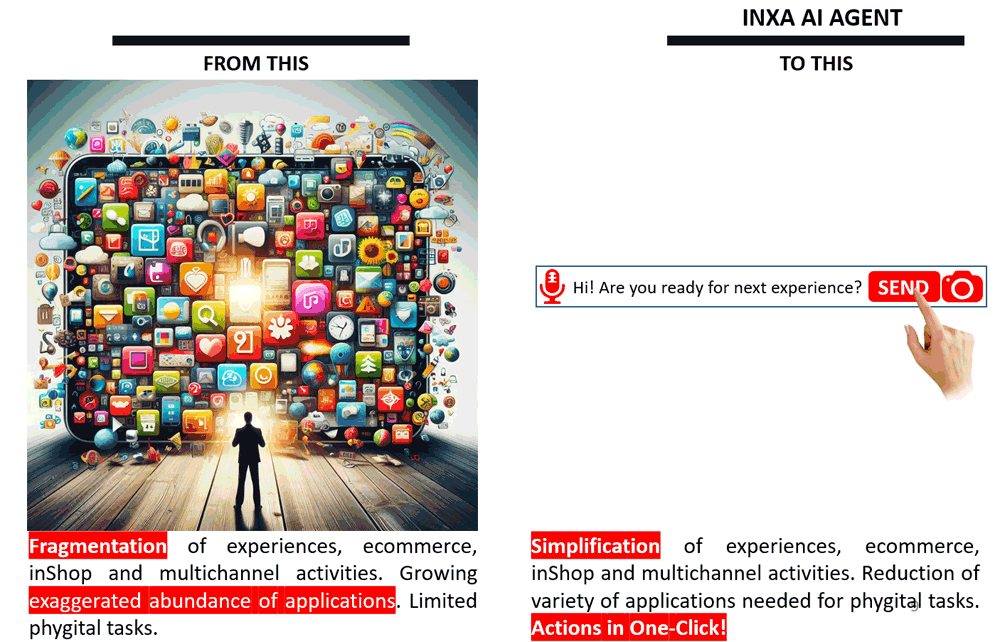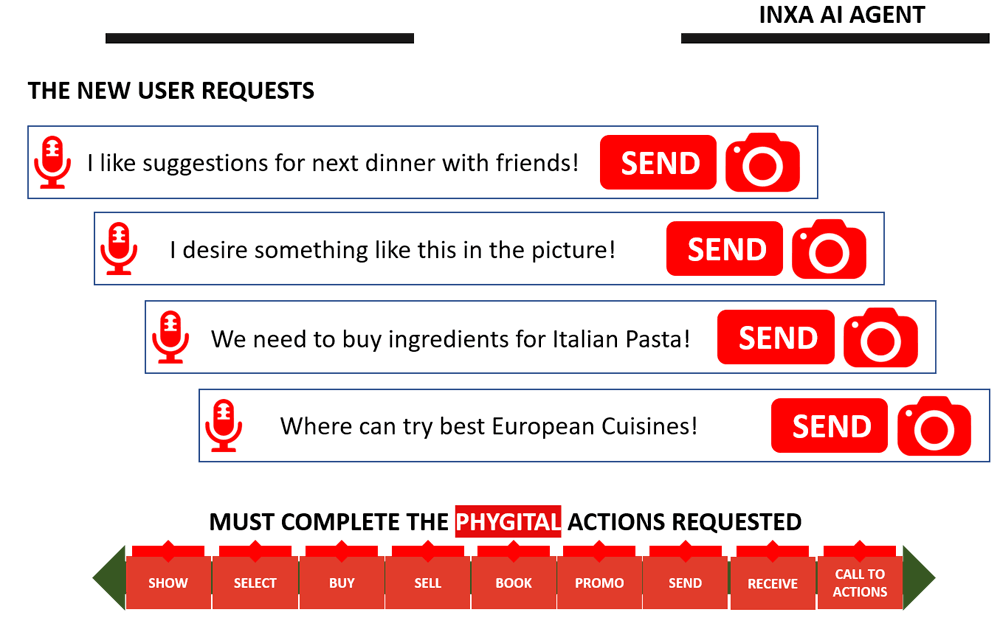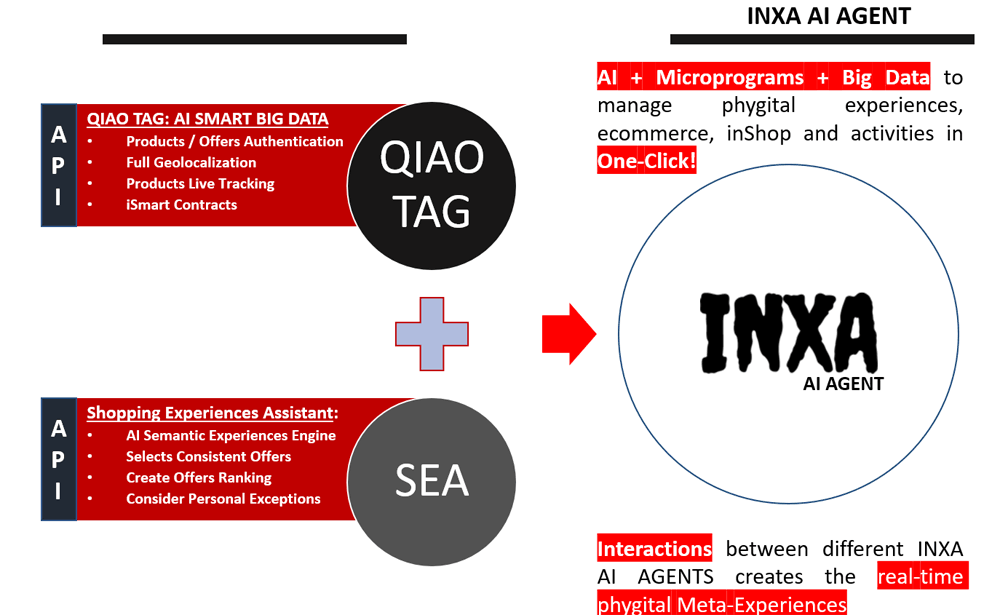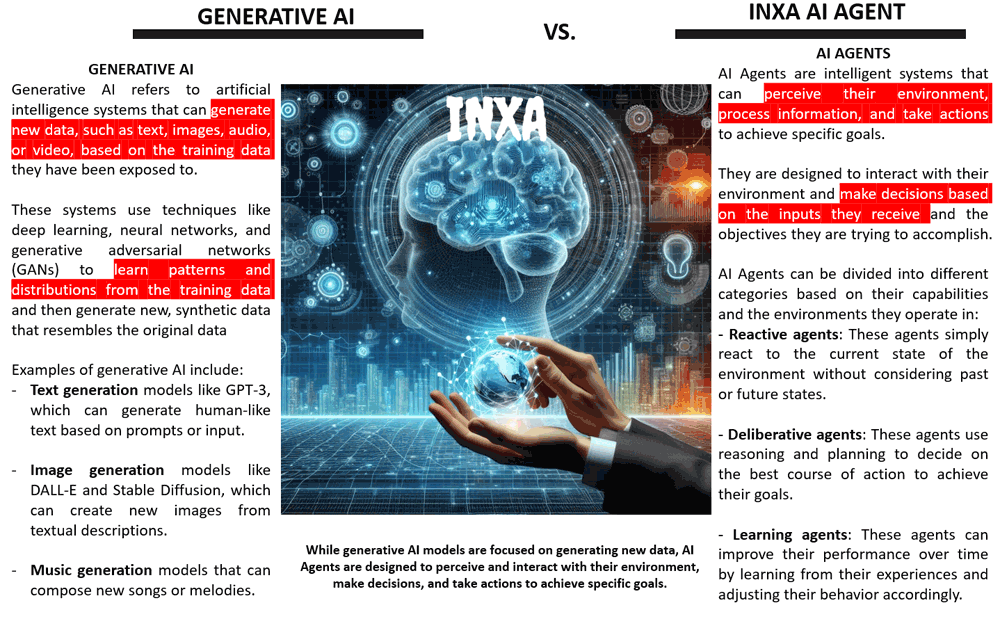INXA AI Agents: Difference between revisions
| Line 324: | Line 324: | ||
=== Concrete Applications of Generative AI by Type of Generative Action === | === Concrete Applications of Generative AI by Type of Generative Action === | ||
Generative AI encompasses a wide range of applications across different domains, harnessing advanced algorithms to create new data in various formats. Here are some key types of generative actions and their concrete applications: | Generative AI encompasses a wide range of applications across different domains, harnessing advanced algorithms to create new data in various formats. Here are some key types of generative actions and their concrete applications: | ||
# ''' | # '''3D Generation''' | ||
'''Applications:''' | '''Applications:''' | ||
* '''Gaming and Virtual Reality''': Generative AI can create realistic 3D models of characters, environments, and objects, enhancing the immersive experience in video games and virtual reality applications. | * '''Gaming and Virtual Reality''': Generative AI can create realistic 3D models of characters, environments, and objects, enhancing the immersive experience in video games and virtual reality applications. | ||
Revision as of 06:33, 4 July 2024
INXA AI Agents
INXA AI Agents are intelligent virtual assistants integrated into the Nexth Experiential Phygital All-in-One XClub platform. These AI Agents are designed to enhance user interactions by providing real-time support, personalized recommendations, and insights, making the platform more intuitive and user-friendly.
Overview
INXA AI Agents leverage advanced artificial intelligence technologies to understand and respond to user needs effectively. They play a crucial role in the Nexth.one ecosystem by facilitating seamless interactions between users and the platform's various features.
From Fragmentation to Semplification

Fragmentation of Experiences in E-commerce and Multichannel Activities
The Challenge of Fragmentation
In today's digital age, consumers are inundated with a vast array of e-commerce platforms, applications, and shopping experiences. This phenomenon, known as the fragmentation of experiences, poses significant challenges for both businesses and consumers. The proliferation of countless apps and channels has led to an exaggerated abundance of options, often overwhelming users and diluting brand engagement.
E-commerce and InShop Integration
As e-commerce continues to grow, the integration of online and in-store (InShop) experiences becomes crucial. However, the seamless blending of these channels is often hampered by the sheer number of applications and platforms. Consumers expect a unified experience, whether they are shopping online or in-store, but the reality is often a fragmented journey. This disjointed approach can lead to confusion, reduced customer satisfaction, and ultimately, lower sales.
Multichannel Activities
Businesses today are leveraging multiple channels to reach their customers, including websites, mobile apps, social media, and physical stores. While multichannel strategies aim to enhance customer engagement and convenience, the excessive abundance of platforms can create inconsistencies in the user experience. Customers might encounter different pricing, availability, and promotions across channels, leading to frustration and mistrust.
The Problem with Exaggerated Abundance
The proliferation of e-commerce applications and platforms has led to an exaggerated abundance that overwhelms consumers. With so many options, users struggle to find and stick with the platforms that best meet their needs. This abundance can also dilute brand loyalty, as consumers might switch between different platforms based on convenience or specific offerings, rather than maintaining a consistent relationship with one brand.
Limited Phygital Tasks
While the integration of physical and digital (phygital) tasks holds promise for creating seamless shopping experiences, its implementation remains limited. Phygital initiatives, such as click-and-collect services, in-store digital kiosks, and augmented reality shopping, are often sporadic and inconsistent. This limited adoption prevents businesses from fully capitalizing on the potential of merging physical and digital experiences to enhance customer engagement and satisfaction.
Addressing Fragmentation
To combat the challenges of fragmented experiences, businesses must prioritize creating cohesive and unified customer journeys across all touchpoints. This involves:
- Streamlining Platforms: Reducing the number of separate applications and integrating functionalities into a single, comprehensive platform can simplify the user experience.
- Consistency Across Channels: Ensuring that pricing, promotions, and product availability are consistent across all channels to build trust and reliability.
- Enhancing Phygital Integration: Expanding and improving phygital initiatives to create more seamless interactions between online and offline experiences.
- Personalization: Leveraging data and AI to personalize the shopping experience, guiding consumers through the plethora of options to find what best suits their needs.
By addressing these challenges, businesses can better navigate the complexities of the modern e-commerce landscape, providing consumers with a more streamlined, satisfying, and cohesive shopping experience.
Simplification of Experiences in E-commerce and Multichannel Activities
In the rapidly evolving digital marketplace, consumers are often overwhelmed by the sheer number of applications and platforms they need to navigate for a seamless shopping experience. This fragmentation not only complicates the user journey but also poses significant challenges for businesses striving to maintain consistent engagement and satisfaction.
Simplification of Experiences
The key to enhancing customer satisfaction lies in the simplification of experiences across e-commerce, inShop, and multichannel activities. By streamlining these processes, businesses can create a more intuitive and cohesive experience that meets consumer expectations.
- Unified User Journey: Simplifying the user journey across various platforms ensures that consumers can transition smoothly between online and offline experiences without facing inconsistencies or disruptions.
- Integrated Solutions: Offering integrated solutions that consolidate different functionalities into a single platform can drastically reduce the complexity of managing multiple applications.
Reduction of Applications for Phygital Tasks
Phygital tasks, which blend physical and digital interactions, are becoming increasingly important in the modern shopping landscape. However, the variety of applications required to manage these tasks can be overwhelming.
- Consolidation of Tools: By reducing the number of applications needed for phygital tasks, businesses can streamline operations and enhance user experiences. A consolidated platform can manage everything from online purchases to in-store pickups, providing a seamless experience for consumers.
- Efficiency and Ease of Use: Fewer applications mean less time spent learning and managing different systems, leading to greater efficiency and ease of use for both customers and staff.
Actions in One-Click!
In today's fast-paced world, convenience is king. The ability to perform actions with a single click can significantly enhance user satisfaction and operational efficiency.
- One-Click Solutions: Implementing one-click solutions for common tasks, such as purchasing, booking, or customer support, can greatly simplify the user experience. This not only reduces friction in the customer journey but also speeds up transaction processes.
- Improved Engagement: One-click actions can lead to higher engagement rates as they reduce the effort required from users, making them more likely to complete desired actions.
By focusing on the simplification of experiences, reducing the variety of applications needed for phygital tasks, and offering one-click solutions, businesses can significantly enhance their e-commerce and multichannel activities. These improvements lead to a more streamlined, efficient, and satisfying experience for consumers, ultimately driving better engagement and loyalty.
The New User Interface
The new interface in the AI generative era is a game-changer, not just about visual changes; These interfaces are not just digital; they are 'phygital’, combining physical and digital elements to create a seamless user experience.
Instead of traditional graphical user interfaces (GUIs), we are moving towards more intuitive, wearable and natural interfaces. These include voice-based interfaces, gesture-based interfaces, and even brain-computer interfaces.

Conversational Interface and Personalized Interactions
The Evolution of Conversational AI
With advancements in natural language processing (NLP), conversational AI interfaces have undergone significant transformation, becoming more natural and context-aware. These interfaces now possess the ability to understand and respond to human language in a way that feels intuitive and engaging. As a result, they are increasingly being integrated into various digital platforms, enhancing user interaction and satisfaction.
Natural and Context-Aware Interactions
The integration of advanced NLP allows conversational AI to not only comprehend user input but also to interpret the context behind it. This means that these AI systems can maintain coherent conversations, understanding nuances and subtleties in human speech. Whether it's a virtual assistant, a customer service chatbot, or an interactive voice response system, these AI-driven interfaces offer a more human-like interaction experience.
AI-Driven Personalization
Personalization is at the forefront of modern digital experiences. AI-driven personalization engines leverage generative models to tailor content to individual preferences and behaviors. By analyzing vast amounts of data, these systems can predict what users are likely to find relevant and engaging. This goes beyond mere recommendations; it includes curating entire user experiences based on individual habits and preferences.
Tailored Experiences
From personalized product recommendations to curated news feeds, conversational AI interfaces provide tailored experiences that resonate with users on a deeper level. For example:
- E-commerce: Personalized product suggestions based on past purchases, browsing history, and individual preferences enhance the shopping experience.
- Media and Entertainment: Curated content recommendations ensure users find the most relevant movies, music, or articles, enhancing user engagement and satisfaction.
- Customer Service: Context-aware chatbots can provide personalized support, addressing user queries with relevant and timely information.
Impact on User Engagement
These personalized interactions not only improve user satisfaction but also drive engagement. When users feel that their needs and preferences are understood and catered to, they are more likely to interact with the platform frequently. This increased engagement can lead to higher conversion rates, customer loyalty, and overall user retention.
Future of Conversational Interfaces
As NLP and AI technologies continue to evolve, we can expect conversational interfaces to become even more sophisticated. Future advancements might include:
- Enhanced Emotional Intelligence: AI systems that can detect and respond to human emotions, providing even more personalized and empathetic interactions.
- Multimodal Interactions: Combining voice, text, and visual inputs to create richer, more immersive conversational experiences.
- Seamless Integration: More seamless integration of conversational AI across various devices and platforms, providing a consistent user experience.
Conversational interfaces and personalized interactions represent the next frontier in user engagement. By leveraging advancements in NLP and AI-driven personalization, businesses can create more natural, context-aware, and tailored experiences that deeply resonate with users. This not only enhances user satisfaction but also drives greater engagement and loyalty, positioning businesses to thrive in the digital age.
The New User Requests Must Complete the Phygital Actions Requested
In the modern retail landscape, where digital and physical experiences are increasingly intertwined, new user requests must effectively address and complete the phygital actions required. Phygital, a blend of physical and digital, represents the seamless integration of online and offline interactions to create a cohesive and enhanced user experience.

Understanding Phygital Actions
Phygital actions encompass a variety of tasks that bridge the gap between the digital and physical worlds. These include:
- Click-and-Collect Services: Allowing users to order online and pick up in-store.
- In-Store Digital Kiosks: Providing digital assistance within physical store locations.
- Augmented Reality (AR) Experiences: Enabling users to visualize products in their real-world environment via their smartphones or AR devices.
- Integrated Customer Support: Combining online chat support with in-store assistance for a consistent customer service experience.
Meeting User Expectations
Today's users demand seamless and efficient phygital interactions. For businesses, this means creating an infrastructure that can handle these requests smoothly and effectively. Here are key strategies to ensure new user requests meet and complete the phygital actions expected:
- Unified Systems: Integrate online and offline systems to ensure real-time synchronization of inventory, customer data, and order processing. This minimizes discrepancies and enhances the user experience.
- User-Friendly Interfaces: Design intuitive and easy-to-navigate interfaces for both digital and physical touchpoints. This ensures users can complete phygital tasks with minimal friction.
- Personalized Experiences: Leverage data analytics and AI to personalize phygital interactions. Tailored recommendations, personalized support, and context-aware services can significantly enhance user satisfaction.
- Robust Support Systems: Establish comprehensive support channels that can assist users in both digital and physical environments. This includes training staff to handle phygital queries and providing robust online help resources.
- Continuous Improvement: Regularly gather user feedback and analyze phygital action data to identify areas for improvement. This ongoing refinement ensures that user requests are consistently met with high-quality phygital solutions.
The Impact of Effective Phygital Actions
Successfully completing phygital actions as requested by new users can lead to numerous benefits for businesses:
- Increased Customer Satisfaction: Seamless phygital experiences enhance overall satisfaction, fostering loyalty and repeat business.
- Higher Conversion Rates: Smooth transitions between online and offline channels can reduce drop-offs and increase conversion rates.
- Enhanced Brand Perception: Effective phygital strategies can position a brand as innovative and customer-centric, improving market reputation.
- Operational Efficiency: Integrated systems and streamlined processes reduce operational complexities, leading to cost savings and better resource allocation.
In a world where digital and physical experiences are increasingly interconnected, it is crucial for businesses to ensure that new user requests are equipped to handle and complete phygital actions. By focusing on unified systems, user-friendly interfaces, personalized experiences, robust support, and continuous improvement, companies can meet these demands effectively. This not only enhances customer satisfaction and loyalty but also drives business success in the evolving retail landscape.
Beyond Generative AI
Beyond Generative Limits
Generative AI, a type of artificial intelligence system, has gained widespread attention for its ability to generate text, images, and other media in response to prompts. These systems, like GPT-3, have demonstrated impressive capabilities in creating human-like content, making them valuable tools in various fields. However, despite their advancements, generative AI systems have significant limitations that hinder their adaptability, customization, and overall effectiveness in more complex and dynamic environments.
Limited Adaptability and Customization
Generative AI systems rely heavily on historical data-driven algorithms. This dependence on past data means that these systems can struggle to adapt to new, unforeseen scenarios or to customize outputs beyond their training. Their responses are constrained by the data they were trained on, which can lead to limitations in generating truly novel or context-specific content.
Lack of Real-Time Data Integratio
One of the major shortcomings of generative AI is its inability to access and integrate third-party real-time data. This means that while they can produce content based on the data they have been trained on, they cannot update their knowledge or respond dynamically to new information as it becomes available. This static nature restricts their usefulness in applications requiring real-time decision-making and adaptability.
Inability to Perform Real Actions Generative AI systems can generate content, but they fall short when it comes to performing real actions, drawing conclusions, generating new ideas, or making decisions in complex situations. Their capabilities are limited to producing outputs based on patterns in their training data, without the capacity for deeper understanding, innovation, or strategic decision-making. This limitation is critical in environments where situational awareness and complex problem-solving are essential.
Static Knowledge Acquisition
Generative AI systems acquire the majority of their knowledge during training sessions. Once trained, they do not continue to learn or update their knowledge base. Moreover, they cannot share their knowledge with third-party systems, making it challenging to integrate them into broader AI ecosystems where continuous learning and information sharing are crucial.
High Implementation Costs
Implementing and maintaining generative AI platforms can be prohibitively expensive. The costs associated with developing, training, and deploying these systems, along with the computational resources required to run them, can be substantial. This financial barrier can limit the accessibility of generative AI technologies to only those organizations with significant resources, thus widening the gap between tech-savvy enterprises and smaller entities.
Looking Beyond Generative AI
To overcome the limitations of generative AI, there is a need to explore more advanced and integrated AI systems that can address these shortcomings. Potential directions for innovation include:
- Adaptive AI Systems: Developing AI that can learn and adapt in real-time, integrating new data and experiences to improve its performance continuously.
- Action-Oriented AI: Creating AI systems capable of performing real actions, making decisions, and generating new ideas based on complex, evolving situations.
- Interoperable AI Ecosystems: Building AI systems that can share knowledge and integrate seamlessly with third-party platforms, enabling a more collaborative and dynamic AI environment.
- Cost-Effective AI Solutions: Innovating to reduce the costs associated with AI implementation and maintenance, making advanced AI technologies more accessible to a broader range of organizations.
While generative AI has made significant strides in the realm of content creation, its limitations in adaptability, real-time data integration, action capability, continuous learning, and cost-effectiveness highlight the need for more advanced AI solutions. By moving beyond the current generative AI paradigm, we can develop more versatile, dynamic, and accessible AI systems that better meet the demands of complex and ever-changing environments.
INXA AI Agents: A Collective Network of Interconnected AI Nodes
INXA AI Agents introduce a groundbreaking approach to digital data representation, inspired by the intricacies of the human brain. This innovative system functions and interacts like a shared biological entity, aptly termed the "eBrain." By rethinking digital data through this lens, INXA AI Agents promise a transformative shift in how we manage and utilize information in the digital world.

The Concept of eBrain
The eBrain is a sophisticated digital construct that mimics the functionality of the human brain. It represents a collective network of interconnected AI nodes, each node acting as a part of a larger, cohesive system. This biological-like entity facilitates complex interactions and decision-making processes by leveraging the strengths of individual nodes while maintaining a unified operational framework.
QIAO TAGs: The Neurons of the Digital Biological World
Central to the functionality of the eBrain are QIAO TAGs. These tags act as the neurons of this new digital biological world, capable of managing deconstructed and geolocated information. Just as neurons in the human brain process and transmit information through synapses, QIAO TAGs interact to handle data in a decentralized and highly efficient manner. This decentralized approach allows for more dynamic and flexible data management, tailored to the specific needs and contexts of each interaction.
eDNAs: Microprograms for Complex Actions
eDNAs are microprograms designed to facilitate joint complex actions between different QIAO TAGs. These microprograms enable coordinated efforts among multiple tags, allowing for sophisticated data processing and action generation. The interaction between eDNAs and QIAO TAGs can produce outcomes that are greater than the sum of their parts, similar to how different parts of the brain collaborate to perform complex tasks.
Dynamic Interactions and Information Generation
In the INXA AI framework, information or actions are generated through the interaction between two or more QIAO TAGs. This interaction-based model allows for a highly adaptable and responsive system, capable of evolving and improving based on real-time data and interactions. The dynamic nature of these interactions ensures that the system can handle a wide range of tasks and challenges, making it incredibly versatile.
Replication and Scalability: Multiple eBrains
One of the most powerful aspects of the eBrain is its ability to be replicated across multiple AI nodes. Each eBrain can operate independently or as part of a larger network, offering unparalleled scalability. This means that the INXA AI system can be deployed in various environments and contexts, from small-scale applications to large, distributed networks, without losing its efficiency or effectiveness.
INXA AI API: Real-Time Connectivity
The INXA AI API serves as the sensory interface that connects the eBrain to third-party systems and external eBrains in real time. These APIs act as sensors, facilitating seamless integration and communication with other digital systems. This connectivity ensures that the eBrain remains up-to-date with the latest information and can interact with external data sources, enhancing its capabilities and broadening its applicability.
INXA AI Agents represent a revolutionary leap in artificial intelligence, redefining digital data representation and management through a biologically inspired framework. With QIAO TAGs functioning as digital neurons, eDNAs enabling complex interactions, and the capacity for dynamic replication and real-time connectivity, INXA AI Agents offer a powerful, adaptable, and scalable solution for the future of AI. This collective network of interconnected AI nodes, or eBrains, promises to transform how we interact with and utilize digital information, paving the way for more intelligent and responsive AI systems.
INXA AI Agents API: AI + Microprograms + Big Data for Phygital Experiences
The INXA AI Agents API combines advanced AI, Microprograms and Big Data to streamline the management of phygital experiences, ecommerce, inShop activities, and more—all in One-Click! This powerful integration offers a seamless and efficient solution for businesses looking to optimize their operations across both physical and digital world.

AI-Powered Management
At the core of INXA AI Agents API is sophisticated artificial intelligence that drives the system’s functionality. This AI component ensures intelligent decision-making, predictive analytics, and real-time responsiveness, enabling businesses to manage complex tasks effortlessly.
Microprograms for Tailored Interactions
Microprograms in the INXA framework act as specialized instructions that execute specific tasks with precision. These microprograms facilitate detailed and tailored actions, ensuring that each task is performed optimally and efficiently. Whether it’s customizing an ecommerce experience or handling inShop activities, microprograms provide the necessary granularity for effective management.
Big Data Integration
The integration of Big Data allows INXA AI Agents API to leverage vast amounts of information for better insights and decision-making. By analyzing trends, customer behavior, and market dynamics, the system can provide businesses with actionable intelligence that enhances their strategic planning and operational execution.
Phygital Experiences
Managing phygital experiences—where physical and digital interactions converge—requires a unique approach. INXA AI Agents API excels in this area by ensuring that all aspects of the customer journey are seamlessly integrated. This includes synchronizing online and offline activities, creating cohesive brand experiences, and maintaining consistency across all touchpoints.
Ecommerce Optimization
For ecommerce, the API provides tools that streamline operations, from inventory management to customer interactions. The AI-driven insights help optimize product listings, enhance customer service, and improve overall sales performance. The system’s ability to adapt and learn from data ensures that ecommerce businesses can stay ahead of the competition.
InShop Activity Management
InShop activities, such as promotions, customer service, and inventory control, are made more efficient with INXA AI Agents API. The system’s real-time capabilities ensure that in-store operations run smoothly, providing customers with a superior shopping experience.
One-Click Solutions
One of the standout features of INXA AI Agents API is its One-Click functionality. This feature simplifies complex processes, allowing businesses to execute tasks with a single click. From updating inventory to launching marketing campaigns, the One-Click solution reduces the time and effort required to manage various activities, enhancing overall efficiency.
INXA AI Agents API offers a comprehensive solution that combines AI, microprograms, and Big Data to manage phygital experiences, ecommerce, inShop activities, and more. With its intelligent, real-time capabilities and One-Click solutions, this API is designed to meet the needs of modern businesses, providing them with the tools to succeed in an increasingly interconnected and digital world.
Generative Ai Vs. INXA Ai Agents
Generative AI refers to artificial intelligence systems that can generate new data, such as text, images, audio, or video, based on the training data they have been exposed to. These systems use techniques like deep learning, neural networks, and generative adversarial networks (GANs) to learn patterns and distributions from the training data and then generate new, synthetic data that resembles the original data.
Examples of generative AI include:
- Text generation models like GPT-3, which can generate human-like text based on prompts or input.
- Image generation models like DALL-E and Stable Diffusion, which can create new images from textual descriptions.
- Music generation models that can compose new songs or melodies.
While generative AI excels in creating new content based on learned data, it has limitations in adaptability, customization, and real-time interaction. These systems rely heavily on historical data and are often unable to incorporate real-time data from external sources. They also face challenges in executing real actions, drawing conclusions, or making decisions based on complex, dynamic situations. Additionally, the implementation and maintenance of generative AI platforms can be costly.
INXA AI Agents, on the other hand, represent a collective network of interconnected AI nodes that rethink the representation of digital data. Inspired by the functioning of the human brain, INXA AI Agents behave in their interactions as a shared biological entity, known as the eBrain.
Key Features of INXA AI Agents:
- QIAO TAGs:
- Act as the neurons of this new digital biological world.
- Capable of managing completely deconstructed and geolocated information.
- eDNAs:
- Microprograms that facilitate joint complex actions between different QIAO TAGs.
- Enable seamless interactions and operations across the network.
- Interaction-Driven Information:
- Information or actions are generated by the interaction between two or more QIAO TAGs.
- This dynamic interaction leads to more adaptable and customized responses.
- Replicable eBrains:
- The eBrain can be replicated across many AI nodes, creating a robust and distributed network.
- Real-Time Connectivity:
- INXA AI API functions as sensors to connect in real time to third-party and external eBrains.
- This connectivity allows for continuous learning, direct access to external data, adaptability, and real-time decision-making.
Advantages of INXA AI Agents over Generative AI:
INXA AI Agents bring a host of advantages over traditional generative AI systems, particularly through their enhanced capabilities in perception, interaction, and decision-making. Here’s an in-depth look at why INXA AI Agents are a step ahead:

Intelligent Systems with Perception and Action
AI Agents are intelligent systems capable of perceiving their environment, processing information, and taking actions to achieve specific goals. Unlike generative AI, which primarily focuses on creating new content based on learned patterns, AI agents are designed to interact with their environment dynamically. This capability allows them to:
- Adapt to Real-Time Changes: AI Agents can continuously assess and respond to changes in their environment, making real-time adjustments to their actions and strategies. This adaptability is crucial for environments that are constantly evolving.
- Make Informed Decisions: By processing a wide array of inputs from their surroundings, AI Agents can make decisions that are informed by the current context and specific objectives.
Categories of AI Agents
AI Agents can be divided into different categories based on their capabilities and the environments they operate in:
- Reactive Agents:
- These agents respond directly to the current state of the environment without considering past or future states.
- They are useful in situations where quick, responsive actions are required.
- Deliberative Agents:
- These agents use reasoning and planning to decide on the best course of action to achieve their goals.
- They can weigh different options and anticipate the outcomes of their actions, making them suitable for complex decision-making scenarios.
- Learning Agents:
- These agents improve their performance over time by learning from their experiences and adjusting their behavior accordingly.
- This continuous learning process allows them to refine their strategies and actions based on past successes and failures.
Advantages of INXA AI Agents
- Real-Time Adaptability:
- Generative AI relies heavily on historical data and predefined algorithms, which limits its adaptability to new situations.
- INXA AI Agents continuously learn from real-time data and interactions, allowing them to adapt to new conditions and unforeseen challenges effectively.
- Interconnected Operations:
- Generative AI operates in isolation, creating content based on learned patterns.
- INXA AI Agents function as part of a collective network (e.g., eBrain) of interconnected AI nodes. This interconnectedness allows them to share information, coordinate actions, and achieve complex goals that are beyond the reach of standalone systems.
- Enhanced Customization:
- Generative AI can generate a wide variety of content but lacks the ability to tailor its actions to specific, individualized contexts.
- INXA AI Agents can manage geolocated information and execute microprograms (eDNAs) that enable highly customized and precise actions based on specific environmental factors and user requirements.
- Continuous Learning and Improvement:
- Generative AI systems acquire most of their knowledge during training sessions and cannot continue learning post-deployment.
- INXA AI Agents are learning agents that improve their performance over time by learning from their interactions and experiences, making them more efficient and effective in the long run.
- Cost Efficiency:
- Generative AI platforms often require significant resources for implementation and maintenance.
- INXA AI Agents, with their distributed nature and real-time adaptability, can potentially reduce costs by leveraging interconnected networks and real-time data, optimizing resource usage and operational efficiency.
INXA AI Agents represent a significant evolution in AI technology, offering superior adaptability, interconnectedness, and real-time decision-making capabilities. These features make them better suited for managing complex, dynamic environments and achieving specific goals with higher efficiency and customization compared to traditional generative AI systems.
Concrete Applications of Generative AI by Type of Generative Action
Generative AI encompasses a wide range of applications across different domains, harnessing advanced algorithms to create new data in various formats. Here are some key types of generative actions and their concrete applications:
- 3D Generation
Applications:
- Gaming and Virtual Reality: Generative AI can create realistic 3D models of characters, environments, and objects, enhancing the immersive experience in video games and virtual reality applications.
- Architecture and Interior Design: AI can generate detailed 3D models of buildings and interior spaces, helping architects and designers visualize projects more effectively.
Example Tools:
- NVIDIA Omniverse: A platform for real-time collaboration and simulation in 3D design and virtual worlds.
Key Features
Real-Time Support
INXA AI Agents provide immediate assistance to users, helping them navigate the platform and find the information or services they need. This real-time support ensures that users have a smooth and efficient experience.
Personalized Recommendations
Using data analysis and machine learning algorithms, INXA AI Agents offer personalized recommendations tailored to each user's preferences and behaviors. This level of personalization enhances user satisfaction and engagement.
Intelligent Insights
INXA AI Agents generate valuable insights based on user interactions and data. These insights help businesses understand user behavior, optimize their offerings, and make informed decisions to improve the overall experience.
Benefits
Enhanced User Experience
The integration of INXA AI Agents into the Nexth.one platform significantly enhances the user experience by providing timely support and personalized interactions. This leads to higher user satisfaction and loyalty.
Increased Efficiency
By automating routine tasks and providing quick responses, INXA AI Agents increase the efficiency of the platform. Users can accomplish their goals faster, and businesses can streamline their operations.
Data-Driven Decisions
The insights generated by INXA AI Agents enable businesses to make data-driven decisions. This helps in identifying trends, optimizing services, and improving user engagement.
Applications
INXA AI Agents can be utilized in various applications across different industries, including:
- Retail: Assisting customers with product information, personalized shopping recommendations, and support.
- Entertainment: Enhancing user experiences with personalized content suggestions and interactive features.
- Education: Providing students with personalized learning resources and support.
- Healthcare: Offering patients virtual assistance, appointment scheduling, and personalized health recommendations.
All-in-One Phygital Ecosystem Management
INXA AI Agents are integrate to the management of Nexth.one’s All-in-One Phygital Ecosystem. This ecosystem combines physical and digital elements to create a cohesive and immersive experience, managed effectively through the intelligent capabilities of INXA AI Agents. Key aspects of ecosystem management include:
- Seamless Integration: Ensuring smooth interaction between various components of the ecosystem, both physical and digital.
- Dynamic Adaptation: Continuously adapting to user needs and preferences to maintain high levels of engagement and satisfaction.
- Operational Efficiency: Streamlining operations and processes within the ecosystem to deliver a seamless user experience.
- Comprehensive Analytics: Utilizing data from user interactions to generate insights and optimize ecosystem performance.
Conclusion
INXA AI Agents are a vital component of the Nexth Experiential Phygital All-in-One XClub platform, bringing advanced AI capabilities to enhance user interactions and provide valuable insights. By leveraging these intelligent agents, businesses can offer more personalized, efficient, and engaging experiences to their users. Additionally, INXA AI Agents play a crucial role in managing the All-in-One Phygital Ecosystem, ensuring seamless integration and operation of its diverse components.
For more information, visit Nexth.one.
